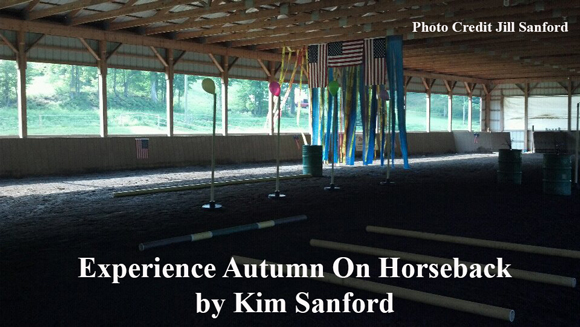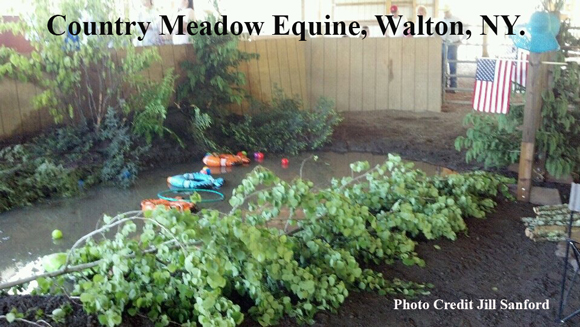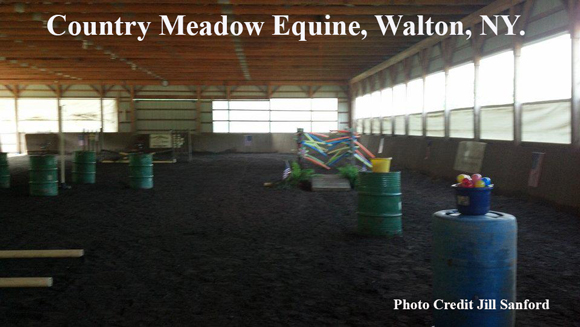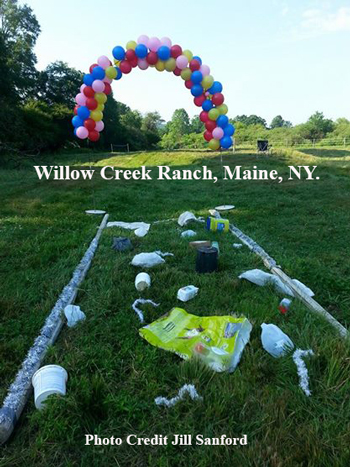Experience Autumn On Horseback
by Kim Sanford

Here we are, seemingly in the blink of an eye, on the cusp of autumn and the “perfect” weather for riding on the horizon. Horse shows are beginning to wind down, for the most part; the fairs are finished for another year and you may be thinking of trying something different with your horse while there is still time to ride before the winter freezes many of us in our tracks as far as riding goes due to lack of facilities or just because we are not winter riders. So what is out there to do while the sun still shines?
Taking to the trails is one of the best ways to really enjoy your horse, the beautiful weather, fall foliage, and different terrain than you ride every day. Just going out alone or with some friends can be a significant stress buster for both you and the horse, especially if your horse is accustomed to trail riding. It is often a welcome change of scenery after a season spent schooling and/or competing in the arena. Even if your horse is not a seasoned trail veteran, with some common sense and patience, most of them adapt well to the new activity and thrive on it. I definitely believe that getting out of the ring/pen as often as possible is good for both horse and rider. Quietly ambling along with your equine partner is good for body and soul.
Now no one is suggesting that everything has to be about competition but maybe you like a challenge and feel that you and your horse are up to something more. If so there are some options out there to satisfy the urge to compete or just challenge yourself and your companion. A couple of stimulating options could be taking your horse to a Hunter Pace or Trail Trial/Obstacle Challenge. They are out there and range from intense contests to casual events. One of the great things about the trail trials and/or challenges is that the playing field is basically level…meaning dressage horses can compete with barrel horses, western pleasure with hunters, polo ponies with endurance horses, you get the picture…it is all about how well they negotiate those obstacles within the time frames if there are some.

For the serious competitor there are some national groups with pages of rules concerning attire, appointments, obstacles, points, etc. for members. One is of them is the Extreme Cowboy Association. The EXCA is the original and only recognized association for the sport of Extreme Cowboy Racing. Another national group a passionate trail rider might want to check out is the American Competitive Trail Horse Association. Many local events have taken elements from these organizations and modified them to meet their needs.
Sometimes they are referred to as “cowboy” challenges, races, etc. But please…don’t let the word “cowboy” get in the way of your experiencing these events if you ride another discipline…they are definitely doable for all types of horses/riders if they already will trail ride and especially if you take the time to familiarize yourself and your horse with a multitude of different obstacles. Not only is this a great idea because it will help to make your horse closer to “bombproof”, and I do use that term loosely because no horse is ever truly “bombproof”, it is just plain FUN. You can use your imagination when introducing new elements into their arena.

There are differences between a trail trial and an obstacle challenge. Generally a “trail trial” is an organized trail ride averaging about 2 hours with 10-12 obstacles which include things and situations a horse and rider might encounter on a trail ride. The ride will be mapped out using as many of the natural occurring elements already existing on a particular trail. You may be asked to walk over logs, open a gate, or maneuver through a creek. Asking the horses to walk around or near live animals…for example, cows in a round pen or a goat staked out next to the trail is not uncommon. Often you will be asked to ride through hanging elements like strips of tarps strung across your path. Some more examples are dragging an object, back up, side passing, small jump(s), rain slicker, mailbox, dismount, etc. and other variations of these examples that are more and more challenging. While out on the trail riders may even encounter odd things like a birthday party, family picnic, mountain bikes, hikers and more. As riders move along the designated trail, the horse/rider team is scored at each obstacle with the judging criteria weighted on how well they negotiate the obstacles. The emphasis is placed on safety, calmness, and accuracy while performing the task.
Trail trials are not usually timed events and riders can travel at their own pace, although  they may be given a time limit to complete the course so that following riders are not held up. They are generally given a standard three attempts to complete the obstacle after which they need to go on to the next one. One of the nice things about trail trials is that riders compete as individuals but can go out in a group. Members of the group cannot assist each other in getting through/over the obstacle, as doing so would result in a DQ for that obstacle. This encourages family participation, with some events offering youth divisions as well as green horse, novice, etc.
they may be given a time limit to complete the course so that following riders are not held up. They are generally given a standard three attempts to complete the obstacle after which they need to go on to the next one. One of the nice things about trail trials is that riders compete as individuals but can go out in a group. Members of the group cannot assist each other in getting through/over the obstacle, as doing so would result in a DQ for that obstacle. This encourages family participation, with some events offering youth divisions as well as green horse, novice, etc.
Any type of clothing that is appropriate for riding is acceptable. Long pants and shoes with heels are mandatory. Helmets are recommended for riders 18 and younger and suggested for all competitors. Some rides require helmets be worn by riders 18 and younger. At some events riders are required to have a halter and lead rope, or halter bridle and hoof pick with them. Any type of saddle and bridle or hackamore is acceptable. Safety for horse and rider is always emphasized with a large helping of fun thrown in.
An obstacle challenge is more likely to be held in an enclosed arena or large field where the whole course can be seen by one judge. They are usually timed as well as judged with both time and scores for each obstacle playing a role in the placings. These types of events allow for spectators. There is a course set up and the obstacles have to be done in the posted order. Many of the same types of obstacles encountered at a trail trial will also be used for the challenges with the addition of different things like working some cows, patterns, etc. They can also be modified in a number of ways to make them more challenging and entertaining for the spectators.
When preparing for these challenges the first thing to do is get your horse out on those trails if s/he is not already doing this. Use your imagination here!! A good idea is to start with the types of obstacles used in standard trail classes and add to them. Once your horse gets comfortable, add an element like plastic bags to the mailbox, or flowers lining the bridge. Keep changing things up because you never know what you will come across at the challenges…sort of like going out on unfamiliar trails. Make sure your horse is comfortable pulling objects (drags) while you are mounted and backing up with that object. The horse should also be able to negotiate a small jump. Familiarize s/he with tarps on the ground, ropes, debris (we use large plastic bottles inside two jump rails to simulate a debris field), use Halloween decorations…the sky is the limit to what you can do. Checking out the websites listed will give you great ideas to build on. Another thing to add to the “toolbox” is the ability to ride circles accurately and make clean lead changes. Oh yeah, it is not uncommon to be asked to snap a bull whip on either side of the horse and other things that can easily spook a horse, so the best advice you can get is to be prepared for practically anything.
Another excellent activity for horse and rider outside of the arena is the hunter pace. I have not personally done one of these but I admit I am intrigued. Over the years I have heard others talk about them and rave about the fun they have had doing them. The impression I have gotten is that you ride a course and the goal is to complete it in a predetermined time which will not be announced before. The closest one to that time wins and so on through the placings. Since my interests are turning more towards the above mentioned trail challenges, hunter paces are also on my “radar” and that has made me want to find out exactly what a hunter pace entails.
Hunter paces are based on the sport of fox hunting but instead of following a pack of hounds who are on a scent trail, a course is marked that will include natural elements found while field hunting with hounds. Sound familiar? There will be jumps for sure as well as ditches and water crossings to negotiate. The pace can be anywhere from five miles to twelve miles give or take. Prior to the day of the competition a group of riders will go out and they are timed by the organizers of the pace. They will ride the course as fast as safely possible and their time will be the pace time. If there is more than one division, there may be separate pace times for each division. Sometimes the winning time will be the average time based on the number of teams in a division. Interestingly there doesn’t appear to be any kind of governing organization for hunter paces so the rules tend to be tailored to the terrain of the pace, the organizers, and the number of teams that particular day.
On the day of the pace you will be given information about the course when you register. Riders are generally sent out in teams of three or four. They will ride the course at a rate that is comfortable for all of them. Riders have the option of jumping or going around the jumps if they choose, making it ideal for a team member who rides western to enjoy the “hunt” with their jumper companions. You are allowed to check the jumps before you attempt them and there is no loss of points for going around. Some events will have checkpoints along the way to monitor the horse’s condition and they may offer refreshments to the riders and water for the horses. Fun is the number-one priority, so don't worry about being too competitive. Again, as with trail challenges, you can be as competitive or as low-key as you wish. The main goal of a hunter pace is to have an enjoyable ride. The prize for coming closest to the pace time is regarded as a secondary goal.
Be aware that when you go to competitions, your horse may become quite excitable. This is normal…good schooling and experience will help overcome this. Arrive as early as you can so you don't feel rushed and can get organized before you ride. Any competition can be a high-stress situation for your horse, no matter how casual it may seem to us. Other horses may come galloping by you, wild turkeys can run across your trail, or you may encounter off-road vehicles. Having a well-schooled atrail-wise horse will make your first hunter pace more enjoyable and safer. Another good thing to remember is that you will be riding in a team of three of four horses, so your horse should be safe ridden in a group.
There are no set rules about what you must wear to a hunter pace. It is not like a real fox hunt that requires you to wear certain formal riding attire at specific times.helmets, boots, riding pants and a neat shirt of some type should all be comfortable and safe. You'll want a saddle you feel safe and comfortable jumping in if you choose to jump. A watch would be a good thing to have so you can keep track of the time you are on course.
Trial trials and hunter paces are a great place to meet new friends. A hunter pace is an excellent way to have fun and experience a small taste of field hunting while spending time with friends and their horses. The trail challenges are also hugely fun and social with an opportunity to expose you and your horse to different experiences on the trail. Both of these activities provide horses and their riders with a fresh perspective. I can only think that getting out of the constant circling and schooling is a win-win for your equine partnership.


